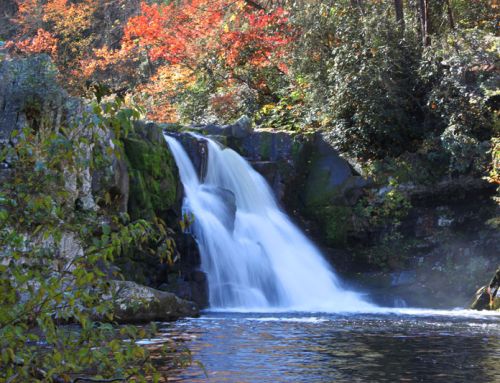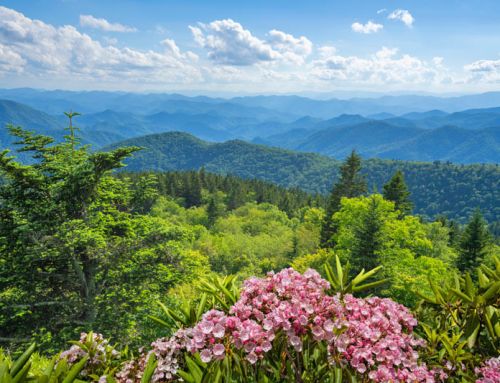Here in the Smokies, we tell tales about our wildlife and flora. For example, we ask children to imaging that a Jack-in-the-Pulpit is not just a plant but a tiny pulpit for the forest creatures. And each spring in March, the forest’s smallest preacher, a wise old cricket, uses the pulpit to share stories of the woods, teaching the animals about the importance of taking care of their home.
As winter’s chilly embrace gradually loosens, the Great Smoky Mountains awaken in a spectacular display of floral brilliance and rekindle the urges to stories to new little ears. March heralds the beginning of this transformation and tradition, a period when the mountainside, seemingly overnight, bursts into a canvas of vibrant colors and delicate fragrances. This blog post is a celebration of that magical transition, focusing on the wildflowers that herald the arrival of spring in one of America’s most beloved natural landscapes. From the delicate Blood Root to the vibrant Red Maple, each flower tells a story of resilience and renewal. Join us as we explore the enchanting world of March wildflowers in the Smoky Mountains, a vivid reminder of nature’s cyclical beauty.
The Wildflowers of March in the Smokies
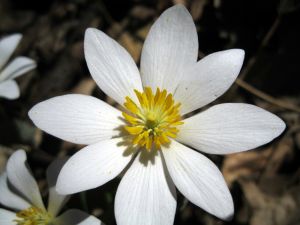 Blood Root (Sanguinaria canadensis): A North American perennial wildflower, Blood Root is known for its striking white petals surrounding a golden-yellow center. It typically blooms in early spring, revealing its beauty in March and April. The plant gets its name from the red-orange sap in its stem and roots.
Blood Root (Sanguinaria canadensis): A North American perennial wildflower, Blood Root is known for its striking white petals surrounding a golden-yellow center. It typically blooms in early spring, revealing its beauty in March and April. The plant gets its name from the red-orange sap in its stem and roots.- Columbine (Aquilegia): With its distinctive bell-shaped flowers and long, nectar-filled spurs, Columbine is a favorite among hummingbirds. Its blooms can vary in color, from blue and purple to red and yellow, appearing in late spring to early summer.
- Dutchman’s Breeches (Dicentra cucullaria): This unique wildflower features white petals that resemble a pair of upside-down pants, hence its name. It thrives in rich, wooded areas, blooming from March to April.
- Hepatica (Hepatica nobilis): An early spring bloomer, Hepatica delights with blue, purple, pink, or white flowers. Each blossom sits atop a single stem, surrounded by leathery leaves. It typically flowers as soon as the snow melts.
 Jack-in-the-Pulpit (Arisaema triphyllum): This woodland perennial is known for its distinctive hooded flower, or “pulpit,” which encloses a spike of tiny blooms. It blooms in spring, with its green and purple hues adding intrigue to the forest floor.
Jack-in-the-Pulpit (Arisaema triphyllum): This woodland perennial is known for its distinctive hooded flower, or “pulpit,” which encloses a spike of tiny blooms. It blooms in spring, with its green and purple hues adding intrigue to the forest floor.- Pepperroot (Lepidium virginicum): A hardy wildflower with small, white blooms clustering atop slender stems. It’s known for its peppery-tasting roots and leaves. Pepperroot flowers from April through the summer months.
- Red Maple (Acer rubrum): Not just a tree but a harbinger of spring, the Red Maple bursts into bloom with small red flowers before its leaves appear. Its flowering period is early spring, around March to April.
- Spice Bush (Lindera benzoin): Before its leaves appear, the Spice Bush lights up the undergrowth with tiny, fragrant yellow flowers. This shrub is a vital early nectar source for bees and butterflies, blooming in early spring.
- Spring Beauty (Claytonia virginica): This delicate wildflower carpets the forest floor in white and pink as
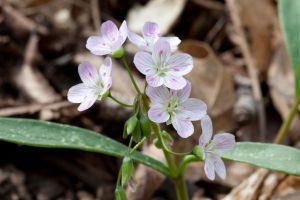 with their profusion of white, fragrant flowers before the leaves appear.
with their profusion of white, fragrant flowers before the leaves appear. - winter fades. Each flower has five petals, often with pink stripes. It blooms from March to May.
- Squirrel Corn (Dicentra canadensis): Related to Dutchman’s Breeches, this flower features heart-shaped white blooms with a hint of pink. It prefers shaded, wooded areas and blooms in early spring.
- Trout Lily (Erythronium americanum): Known for its mottled leaves, which resemble a trout’s skin, and its yellow, bell-shaped flowers. It blooms in early to mid-spring.
- Violets (Viola): A diverse genus with over 500 species, violets typically have heart-shaped leaves and small, fragrant flowers in shades of purple, blue, and white. They bloom in early spring.
- Wild Plum (Prunus americana): Early spring brings the blossoming of Wild Plum trees,Wind Flower (Anemone nemorosa): Part of the buttercup family, this delicate wildflower has white petals surrounding a golden center. It blooms in early spring, dancing in the slightest breeze.
- Yellow-Root (Xanthorhiza simplicissima): A unique shrub with bright yellow roots, Yellow-Root produces small, purple-brown flowers in early spring. Its bitter roots have been used medicinally.
Where to See The Wildflowers
For those eager to experience the vibrant display of March wildflowers in the Great Smoky Mountains, there are several trails renowned for their springtime beauty. Each trail offers a unique glimpse into the diverse botanical life thriving in this rich ecosystem. From the early blooms of spring beauties to the striking presence of the jack-in-the-pulpit, these paths wind through habitats that support an array of ephemeral wildflowers.
- Porters Creek Trail is celebrated for its spectacular wildflower displays from late March through April, making it a must-visit for early spring.
- Little River Trail provides a wonderful opportunity for wildflower viewing between mid-March and April, with a variety of species like hepaticas and yellow trillium.
- Schoolhouse Gap Trail offers a gentle hike with a diversity of spring and summer flowers, including some unusual species.
- Chestnut Top Trail is usually the first to bloom with spring beauties in March, followed by a succession of wildflowers throughout the spring.
- Deep Creek Trail and Oconaluftee River Trail are also recommended for their abundant wildflower displays in the spring months.
Each of these trails offers a different aspect of the Smokies’ wildflower season, providing breathtaking views and a deeper appreciation for the park’s natural wonders. Whether you’re a seasoned botanist or simply a lover of nature’s beauty, these trails promise an unforgettable experience amidst the awakening of spring in the Great Smoky Mountains.
Convenient Places to Stay
The Meadowlark Motel in Maggie Valley, NC with its unique blend of traditional comfort and modern convenience, is well-situated for exploring the Great Smoky Mountains and its trails. Its location offers easy access to a variety of outdoor activities and is a good starting point for adventures in the mountains
For other places to stay near the Great Smoky Mountains that offers convenient access to the beautiful wildflower trails, consider these options in addition to the Meadowlark Motel:
- Airbnb Rentals: There are several highly-rated cabins available in Gatlinburg and Sevierville. These range from modern honeymoon cabins with luxurious amenities like oversized bathtubs and hot tubs, to cozy hideaways near fishing ponds, all offering a good base for exploring the Smoky Mountains and their spring wildflower displays.
- Vrbo Vacation Homes: Options include “A Mountain Cottage,” which is pet-friendly and comes with a hot tub and WiFi, and properties with mountain views, hot tubs, and king beds. There are accommodations to suit groups of various sizes, from cozy cottages to larger homes with multiple bedrooms.
- Booking.com Listings: If you’re looking for hotel accommodations, Margaritaville Island Hotel in Pigeon Forge offers luxury with free WiFi, a restaurant, bar, and fitness center. The Inn at Apple Valley in Sevierville is another great choice, located near attractions and offering a welcoming stay with a view of the Little Pigeon River. Jonathan Creek Inn and Villas in Maggie Valley offers an indoor swimming pool and is situated close to Cataloochee Ski Area.
These accommodations offer a mix of luxury and comfort, perfect for relaxing after a day of hiking and wildflower viewing in the Great Smoky Mountains.
Conclusion
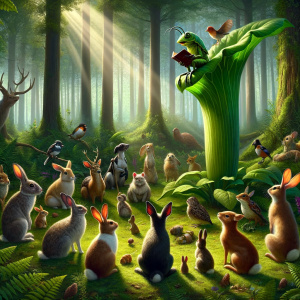 As we draw the curtain on our journey through the enchanting world of March wildflowers in the Smoky Mountains, let’s recall the magical story of Jack-in-the-Pulpit, a humble yet mystical flower that serves as a natural pulpit for the forest’s tiny creatures. This tale, rich with lessons of nature’s cycles and the interconnectivity of life, mirrors the essence of what we’ve explored.
As we draw the curtain on our journey through the enchanting world of March wildflowers in the Smoky Mountains, let’s recall the magical story of Jack-in-the-Pulpit, a humble yet mystical flower that serves as a natural pulpit for the forest’s tiny creatures. This tale, rich with lessons of nature’s cycles and the interconnectivity of life, mirrors the essence of what we’ve explored.
The vibrant blossoms of March not only paint the forest floor with bursts of color but also weave a story of renewal, resilience, and the intricate tapestry of life. Each petal and leaf, much like the characters in our story, plays a crucial role in the grand spectacle of spring. May the story of Jack-in-the-Pulpit inspire us to look closer, appreciate the small wonders underfoot, and understand our place within the natural world. As we leave the forest behind, let’s carry forward the spirit of curiosity and stewardship for the magnificent landscapes that have shared their springtime secrets with us.



